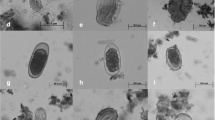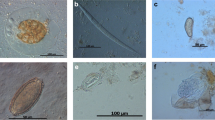Abstract
A longitudinal study of nematode infection in chimpanzees was conducted between 1989 and 1994 on the M group chimpanzees of the Mahale Mountains National Park, Tanzania during two annual dry and rainy season periods and a third rainy season. Chemical and physical antiparasite properties of medicinal plant use against the strongyle nematodeOesophagostomum stephanostomum have recently been reported at Mahale. Here, the incidence of nematode infections were analyzed for seasonal trends to elucidate the possible influence of parasite infection on previously reported seasonality of medicinal plant use and to test the hypothesis that the use of these plants is stimulated byO. stephanostomum. The number of chimpanzees infected byO. stephanostomum was significantly higher in the rainy season than in the dry season of both 1989–1990 and 1991–1992. However, the incidence ofTrichuris trichura andStrongyloides fuelleborni showed no seasonality. Reinfection of individuals byO. stephanostomum occurred in synchrony with annual variation in rainfall: there was a sharp rise in the occurrence of new infections per individual within one to two months after the beginning of the first heavy rains of the season. This pattern coincides with the reproductive cycle of this nematode species.O. stephanostomum (95%) infections were associated significantly more frequently with medicinal plant use than eitherT. trichiura (50%) orS. fuelleborni (40%) infections. These observations are consistent with previous reports for the increased use of these plants during the rainy season and are consistent the hypothesis that medicinal plant use is stimulated byO. stephanostomum infection.
Similar content being viewed by others
References
Allison, A. C. 1982. Co-evolution between hosts and infectious disease agents and its effect on virulence. In:Population Biology of Infectious Diseases,Anderson,R. M.;May,R. M. (eds.), Springer-Verlag, Berlin, pp. 245–267.
Anderson, R. C. 1992.Nematode Parasites of Vertebrates: Their Development and Transmission. C.A.B. International, Walingford.
Anderson, R. M.;May, R. M. 1982.Population Biology of Infectious Diseases. Springer-Verlag, Berlin.
Ash, L. R.;Orihel, T. C. 1987.Parasites: A Guide to Laboratory Procedures and Identification. Amer. Society of Clinical Pathologists Press, Chicago.
Beaver, P. C.;Jung, R. C.;Cupp, E. W. 1984.Clinical Parasitology (9th ed.). Lea & Febiger, Philadelphia.
Behnke, J. M. 1987. Evasion of immunity by nematode parasites causing chronic infections.Adv. Parasitol., 26: 1–71.
Bernard, C. J.;Behnke, J. M. 1990.Parasitism and Host Behaviour. Taylor & Francis, London.
Brack, M. 1987.Agents Transmissible from Simians to Man. Springer-Verlag, Berlin.
Eley, R. M.;Strum, S. C.;Muchemi, G.;Reid, G. D. F. 1989. Nutrition, body condition, activity patterns, and parasitism of free-ranging troops of olive baboons (Papio anubis) in Kenya.Amer. J. Primatol., 18: 209–219.
File, S. K.;McGrew, W. C.;Tutin, C. E. G. 1976. The intestinal parasites of a community of feral chimpanzees,Pan troglodytes schweinfurthii.J. Parasitol., 62: 259–261.
Freeland, W. J. 1980. Mangabey (Cercocebus albigena) movement patterns in relation to food availability and fecal contamination.Ecology, 61(6): 1297–1303.
Futuyma, D. J.;Slatkin, M. 1983.Coevolution. Sinauer Associates, Sunderland.
Georgi, J. R. 1985.Parasitology for Veterinarians. Saunders, Philadelphia.
Goodall, J. 1983. Population dynamics during a 15 year period in one community of free-living chimpanzees in the Gombe National Park, Tanzania.Z. Tierpsychol., 61: 1–60.
Hamilton, W. D. 1964a. The genetical evolution of social behavior, I.J. Theoret. Biol., 7: 1–16.
Hamilton, W. D. 1964b. The genetical evolution of social behavior, II.J. Theoret. Biol., 7: 17–52.
Hamilton, W. D.;Zuk, M. 1982. Heritable true fitness and bright birds: a rule for parasites?Science, 218: 384–387.
Hart, B. 1990. Behavioral adaptations to pathogens and parasites: five strategies.Neurosi. Behav. Rev., 14: 273–294.
Hausfater, G.;Meade, B. J. 1982. Alternation of sleeping groves by yellow baboons (Papio cynocephalus) as a strategy for parasite avoidance.Primates, 23: 287–297.
Hill, A. 1985. Nutritional aspects of parasite infection.Prog. Food Nut. Sci., 9: 227–256.
Hiraiwa-Hasegawa, M.;Hasegawa, T.;Nishida, T. 1984. Demographic study of a large-sized unitgroup of chimpanzees in the Mahale Mountains, Tanzania: a preliminary report.Primates, 25: 401–413.
Huffman, M. A. 1993. An investigation of the use of medicinal plants by wild chimpanzees: current status and future prospects.Prim. Res., 9: 179–187.
Huffman, M. A.;Gotoh, S.;Izutsu, D.;Koshimizu, K.;Kalunde, M. S. 1993. Further observations on the use of the medicinal plant,Vernonia amygdalina Del. by a wild chimpanzee, its possible affect on parasite load, and its phytochemistry.Afr. Stud. Monogr., 14: 227–240.
Huffman, M. A.;Nishida, T.;Uehara, S. 1990. Intestinal parasites and medicinal plant use in wild chimpanzees: possible behavioral adaptation for the control of parasites. In:Mahale Mountains Chimpanzee Research Project, Ecological Rept. (No. 72), Kyoto Univ., Kyoto.
Huffman, M. A.;Page, J. E.;Sukhdeo, M. V. K.;Gotoh, S.;Kalunde, M. S.;Chandrasiri, T.;Towers, G. H. N. 1996. Leaf-swallowing by chimpanzees, a behavioral adaptation for the control of strongyle nematode infections.Int. J. Primatol., 17: 475–503.
Huffman, M. A.;Seifu, M. 1989. Observations on the illness and consumption of a possibly medicinal plantVernonia amygdalina Del., by a wild chimpanzee in the Mahale Mountains National Park, Tanzania.Primates, 30: 51–63.
Huffman, M. A.;Wrangham, R. W. 1994. The diversity of medicinal plant use by chimpanzees in the wild. In:Chimpanzee Cultures,Wrangham,R. W.;McGrew,W. C.;DeWaal,F. B.;Heltne,P. G. (eds.), Harvard Univ. Press, Cambridge, Massachusetts, pp. 129–148.
Jisaka, M.;Kawanaka, M.;Sugiyama, H.;Takegawa, K.;Huffman, M. A.;Ohigashi, H.;Koshimizu, K. 1992. Antischistosomal activities of sesquiterpene lactones and steroid glucosides fromVernonia amygdalina, possibly used by wild chimpanzees against parasiterelated diseases.Biosci. Biotech. Biochem., 56: 845–846.
Kawabata, M.;Nishida, T. 1991. A preliminary note on the intestinal parasites of wild chimpanzees in the Mahale Mountains, Tanzania.Primates, 32: 275–278.
McGrew, W. C.;Tutin, C. E. G.;Collins, D. A.;File, S. K. 1989. Intestinal parasites of sympatricPan troglodytes andPapio spp. at two sites: Gombe (Tanzania) and Mt. Assirik.Amer. J. Primatol., 17: 147–155.
Myers, B. J.;Kuntz, R. E. 1972. A checklist of parasites and commensals reported for the chimpanzee (Pan).Primates, 13: 433–471.
Nelson, G. S. 1960. Schistosome infections as zoonoses in Africa.Transcrip. Royal Soc. Trop. Med. Hyg., 54: 301–314.
Nishida, T. 1990. A quarter century of research in the Mahale Mountains: an overview. In:The Chimpanzees of the Mahale Mountains: Sexual and Life History Strategies,Nishida,T. (ed.), Univ. of Tokyo Press, Tokyo, pp. 3–35.
Nishida, T.;Nakamaura, M. 1993. Chimpanzee tool use to clear a blocked nasal passage.Folia Primatol., 61: 218–220.
Nishida, T.;Takasaki, H.;Takahata, Y. 1990. Demography and reproductive profiles. In:The Chimpanzees of the Mahale Mountains: Sexual and Life History Strategies,Nishida,T. (ed.), Univ. of Tokyo Press, Tokyo, pp. 63–97.
Nishida, T.;Uehara, S. 1983. Natural diet of chimpanzees (Pan troglodytes): long-term record from the Mahale Mountains, Tanzania.Afr. Stud. Monogr., 3: 109–130.
Ohigashi, H.;Huffman, M. A.;Izutsu, D.;Koshimizu, K.;Kawanaka, M.;Sugiyama, H.;Kirby, G. C.;Warhurst, D. C.;Allen, D.;Wright, C. W.;Phillipson, J. D.;Timmon-David, P.;Delnas, F.;Elias, R.;Balansard, G. 1994. Toward the chemical ecology of medicinal plantuse in chimpanzees: the case ofVernonia amygdalina (Del.), a plant used by wild chimpanzees possibly for parasite-related diseases.J. Chem. Ecol., 20: 541–553.
Ohigashi, H.;Takagaki, T.;Koshimizu, K.;Watanabe, K.;Kaji, M.;Hoshino, J.;Nishida, T.;Huffman, M. A.;Takasaki, H.;Jato, J.;Muanza, D. M. 1991. Biological activities of plant extracts from tropical Africa.Afr. Stud. Monogr., 12(4): 201–210.
Page, J. E.;Balza, F.;Nishida, T.;Towers, G. H. N. 1992. Biologically active diterpenes fromAspilia mossambicensis, a chimpanzee medicinal plant.Phytochem., 31: 3437–3439.
Phillips-Conroy, J. E. 1986. Baboons, diet, and disease: food plant selection and schistosomiasis. In:Current Perspectives in Primate Social Dynamics,Taub,D. M.;King,F. A. (eds.), Reinhold, Van Nostrand, New York, pp. 287–304.
Phillips-Conroy, J. E.;Knopf, P. M. 1986. The effects of ingesting plant hormones on schistosomiasis in mice: an experimental study.Biochem. System. Ecol., 14: 637–645.
Price, P. W. 1980.Evolutionary Biology of Parasitism. Princeton Univ. Press, Princeton.
Rodriguez, E.;Wrangham, R. W. 1993. Zoopharmacognosy: the use of medicinal plants by animals. In:Phytochemical Potentials of Tropical Plants,Downum,K. R.;Romeo,J. T.;Stafford,H. A. (eds.), Plenum Press, New York, pp. 89–105.
Sharman, M. J. 1981. Feeding, ranging and social organization of the Guinea baboon. Ph.D. thesis, Univ. of St. Andrews.
Takasaki, H.;Nishida, T.;Uehara, S.;Norikoshi, K.;Kawanaka, K.;Takahata, Y.;Hiraiwa-Hasegawa, M.;Hasegawa, T.;Hayaki, H.;Masui, K.;Huffman, M. A. 1990. Appendix: summary of meteorological data at Mahale Research Camps, 1973–1988. In:The Chimpanzees of the Mahale Mountains: Sexual and Life History Strategies, Nishida, T. (ed.), Univ. of Tokyo Press, Tokyo, pp. 291–300.
Toft, C. A.;Aeschlimann, A.;Bolis, L. 1991.Parasite-Host Associations: Coexistence or Conflict? Oxford Science Publ., Oxford.
Towers, G. H. N.;Abramowski, Z.;Finlayson, A. J.;Zucconi, A. 1985. Antibiotic properties of thiarubrine-A, a naturally occurring dithiacyclohexadiene polyine.Planta Medica, 3: 225–229.
Uehara, S.;Nyundo, R. 1983. One observed case of temporary adoption of an infant by unrelated nulliparous females among wild chimpanzees in the Mahale Mountains, Tanzania.Primates, 24: 456–466.
Wrangham, R. M. 1995. Leaf-swallowing by chimpanzees, and its relation to a tapeworm infection.Amer. J. Primatol., 37: 297–303.
Wrangham, R. W.;Goodall, J. 1989. Chimpanzee use of medicinal leaves. In:Understanding Chimpanzees,Heltne,P. G.;Marquardt,L. A. (eds.), Harvard Univ. Press, Cambridge, Massachusetts, pp. 22–37.
Wrangham, R. W.;Nishida, T. 1983.Aspilia spp. leaves: a puzzle in the feeding behavior of wild chimpanzees.Primates, 24: 276–282.
Author information
Authors and Affiliations
About this article
Cite this article
Huffman, M.A., Gotoh, S., Turner, L.A. et al. Seasonal trends in intestinal nematode infection and medicinal plant use among chimpanzees in the Mahale Mountains, Tanzania. Primates 38, 111–125 (1997). https://doi.org/10.1007/BF02382002
Received:
Accepted:
Issue Date:
DOI: https://doi.org/10.1007/BF02382002




